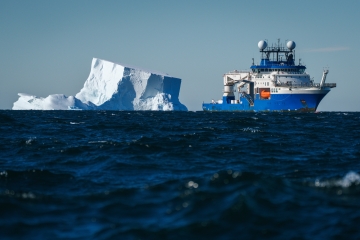SATS print 240_360 px width.jpg

Research vessel Falkor (too) conducts research in the South Atlantic Ocean. Credit: Alex Ingle/Schmidt Ocean Institute, CC BY-NC-SA
It’s been 100 years since people discovered the existence of the colossal squid, known by its scientific name Mesonychoteuthis hamiltoni, when a scientist found pieces of two huge squids in a sperm whale’s stomach. Although several (mostly dead) specimens have been collected since then—including one weighing over 1,000 pounds in 2007—scientists have never managed to film one of these creatures in its natural habitat. That changed this year when researchers captured video of a baby colossal squid near the South Sandwich Islands in the South Atlantic Ocean.
Scientists aboard the research vessel Falkor (too), from the Schmidt Ocean Institute in California, found the squid with a remotely operated vehicle about 2,000 feet below the surface during their 35-day expedition. At barely a foot long, the juvenile squid could grow up to 23 feet long, though some estimates suggest females may grow to 46 feet long, the length of a standard school bus. As the largest known invertebrates on earth, colossal squids also have the largest known eyes of in the animal kingdom. Each adult eye measures 12 to 16 inches across—about the size of a beach ball—with a lens at least 4 inches in diameter.
Scientists know very little about the behavior of colossal squids since they have never been able to observe them in natural settings. They believe the creatures are ambush predators because of the strong, sharp hooks in the middle of their arms that can be used to capture prey and fight off predators such as southern elephant seals and sperm whales. In fact, many sperm whales have been found with scars from these hooks. Now that scientists have found a juvenile, they hope they’ll find more and be able to start learning about these giants’ natural behaviors.


